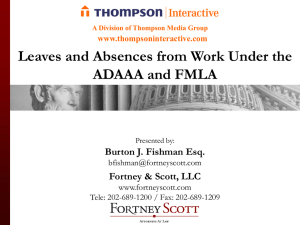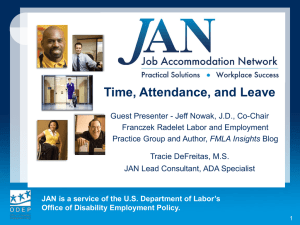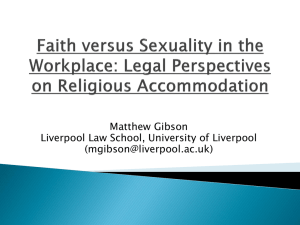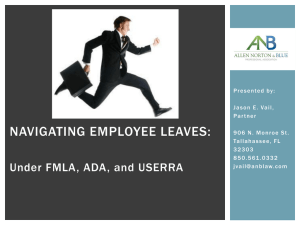2013 Annual Conference: Don`t Leave Me Now: Integrated Leave
advertisement
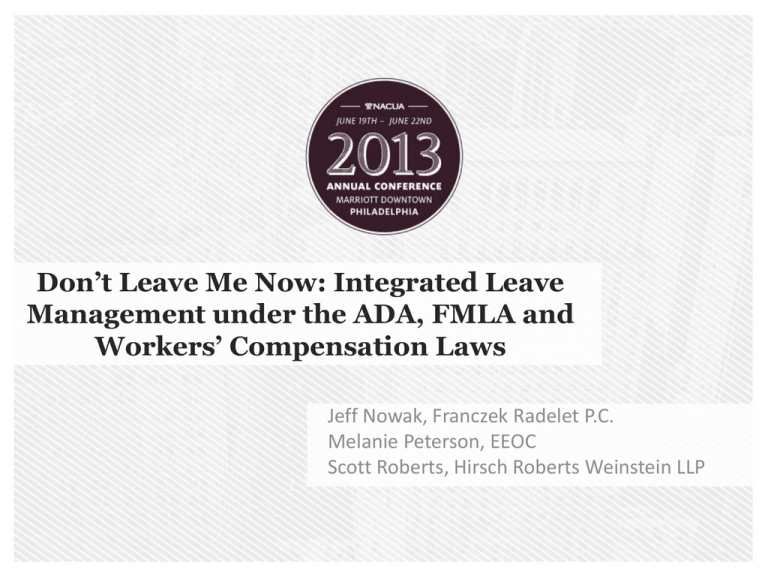
Don’t Leave Me Now: Integrated Leave Management under the ADA, FMLA and Workers’ Compensation Laws Jeff Nowak, Franczek Radelet P.C. Melanie Peterson, EEOC Scott Roberts, Hirsch Roberts Weinstein LLP Tackling the Three-Headed Monster AGENDA Goal: Provide overview of the many, many issues that arise when trying to tame the three-headed monster – FMLA, ADA, and Workers’ Comp Methodology: Interactive Case Studies, or “Let’s Just Jump Right in to the Deep End of the Pool” Q & A Introduction of Panel Case Study #1 Case Study #1 – Issue Spotting Where the FMLA Ends, ADA Begins • Does employer have obligation to communicate? • Personnel policy changes under ADAAA – Obligation not to discriminate, reasonable accommodation • What are employee’s obligations? • What does employer’s communication look like? 6 I Just Called…to say…I Love You! • As of [date], you will have exhausted all FMLA leave available to you. Presently, you have no additional leave time available. We understand that you currently are unable to work through [date]. As such, we expect you to return to work the following workday, [date]. If you fail to report for work on your expected return date and have not contacted us, we will presume that you have voluntarily resigned your employment. • If you are not able to return to work by the above date, or if you believe you may need some assistance or accommodation to resume your normal job duties, or if there is any other information about your return to work that you wish to call to our attention, you must contact [contact name / telephone no.] as soon as possible before this date. • Before returning to work, you will be required to provide a return-towork certification confirming that you are able to perform the essential duties of your position and are able to return to work. 7 Can the School Terminate Kathy? • Kathy contacts you: needs another 4 weeks off, since she’s recuperating from surgery to remove fluid from her back. “I know I am a burden to you, but I still am in pain. I miss you guys.” • Her doctor will review her status at three weeks to determine whether she can return to work • What do you think? 8 What Information Can Employer Obtain? • Medical facts/condition at issue • How these affect employee’s ability to perform essential job functions, and which job functions • Whether HCP can identify any accommodations that would help employee perform job functions • Expected date upon which employee can perform essential job functions • Will requested leave allow employee to perform essential functions now or in immediate future? 9 Kathy’s Second extension… • • • • After doctor appointment, Kathy avoids you Give her an extra week (a total of 5 weeks) & call her Kathy still cannot return to work Requests another 4 weeks. Pressure in back is diminishing, but still in pain. Physician wants to meet with her in four weeks for follow up. (“Doc thinks I may be ready to return…”) • Prescription note: “Off work until July 19, 2013. Will re-evaluate.” • Time to Terminate? What are the considerations? 10 “Costs” to Employer: Undue Hardship? • Significant losses in productivity because work is completed by less effective, temporary workers or last-minute substitutes, or overtired, overburdened employees working overtime who may be slower and more susceptible to error • Lower quality and less accountability for quality • Lost sales (?) • Less responsive client service and increased client dissatisfaction • Deferred projects • Increased burden on management staff required to find replacement workers, or readjust workflow or readjust priorities in light of absent employees • Increased stress on overburdened co-workers • Lower morale 11 But really, How does this work? • Give serious consideration to employee’s request • Interview supervisory staff to determine how: – employee’s work has been absorbed now & in future – what are the hardships created by the absence • Document the alternatives you have examined to extend leave and the undue hardship • Before termination: make sure you can justify—with documentation—the business rationale for the decision 12 Henry v. United Bank • Two other credit analysts and Henry's boss had taken on extra work that resulted from Henry's absence, which in turn strained the department • No other employee available, causing an overload on dept. • Hiring a temp employee was not an advisable business practice, due to the confidential nature of client information and particularized training involved • Analysts' loan review responsibilities expected to increase because of increased regulations on the financial industry • The Bank was expecting an increase in new loans, creating further stress on a short-handed staff. 13 Follow United Bank’s lead • Carefully administer FMLA leave • Communicate regularly with the employee while he or she is on FMLA leave • If additional leave beyond FMLA is requested: – Individually assess the individual's return to work with or without a reasonable accommodation – Interview your managers/employees – Document how the continued absence significantly impacts your operations 14 Case Study #2 Case Study #2 – Issue Spotting Reasonable Accommodation & ADA • Is Gia entitled to a change in the way things are normally done at work so she can perform her grant-writing job? • Pregnancy not an impairment under the ADA. – What about complications due to pregnancy? – Medical complications due to pregnancy are covered under the ADA. – Employer can ask for more medical information if necessary to determine whether or not to grant a reasonable accommodation. Employer Must Engage in the Interactive Process re: Request for Accommodation • Request for reasonable accommodation need not be formal or even made by the individual in need of the accommodation. • Gia asked to telework. SU’s response is to place Gia on FMLA leave. – Has need for the interactive process been fulfilled? – NO!! – Why not? You name it: No discussion with her. No request for any additional information. No discussion of how it would be accomplished. No presentation of alternatives. Accommodations Granted to Remove Barriers to Performing Essential Functions of the job. • Gia is a grant writer -- what are the essential functions of her job? – Writes, coordinates tours, uses SU computer. • Can Gia be accommodated by working from home? – Writing – can be done at home. – Coordinates tours. Does not conduct them. – SU computer – could use an SU laptop or desktop computer with the requisite encrypted drive. – Climbing ladders not a part of her job. Can she work unsupervised? – Has she/have others been allowed to telework? • Regular attendance is not an essential function of Gia’s job. – Writing can be done at anytime. – Gia can return phone calls and e-mail messages at anytime and from nearly anywhere. Gia does not have to be in her office to do her work. – There is no indication she needs to be in her office during any particular hours. If some set hours are necessary, working from home should not be a barrier. Unpaid Leave Can Be a Reasonable Accommodation under the ADA. • ADA allows an indeterminate amount of leave, barring undue hardship, as a reasonable accommodation. – Unspecified is not indeterminate. – Time for surgery, to recuperate, etc. – May result in extended medical leave after FMLA has expired. • Exhaustion of the 12 weeks of FMLA leave does not constitute undue hardship under the ADA. – Employer should allow employee to exhaust accrued paid leave first. • Employer may ask the employee about why the original prediction of the duration of leave was wrong and why more time is needed. EEOC Enforcement Guidance. • BUT, Gia did NOT even ask for FMLA leave. SU forced it on her. ADA: Reasonable Accommodation Request Granted Unless There is Undue Hardship. • Employer has to establish the undue hardship. • SU has raised a safety concern. OK under the ADA? – Likely not. Why not? • • • • Paternalistic. Not based on relevant facts. No demonstration she is of harm to herself or others. No medical evaluation concerning the likelihood of any such danger. – What about Title VII of the Civil Rights Act of 1964? • Pregnancy Discrimination Act modified Title VII. • SU running the risk of a pregnancy discrimination lawsuit. What Role Does Gia’s MS play here? • Should be no role. Why? • She has not asked for reasonable accommodation for her MS. • SU knows about her MS, but has insufficient reason to believe that an accommodation was requested for her MS so she could perform her essential functions. • Cannot deem someone a safety risk just because employer knows of a potentially disabling condition. • Employer cannot determine mitigating measures for an employee, including medication for MS!! • SU running the risk of a disability discrimination lawsuit for acting on knowledge of Gia’s MS and the fact that she has not been taking her meds during her pregnancy. 100% Healed Policies Violate the ADA. • 100% healed policies are contrary to employee rights to reasonable accommodations. • ADA places no time limitation on reasonable accommodation. • SU’s willingness to hire Gia back when she is 100% healed does not save SU from the fact that it terminated Gia due to her disability. SU’s Main Failings • Failure to conduct individualized assessment. • No interactive process. • Forcing on FMLA and automatic termination resulted robbed employee of her right to reasonable accommodation. • Acted on fear, not facts. • Requires a fitness-for-duty examination to re-hire Gia, which to be lawful must be job-related and consistent with business necessity. • Made an EEOC investigator’s job really easy - not in a good way for SU. Case Study #3 Light Duty under FMLA • Can employer offer light duty instead of FMLA leave? – 825.207(e): Employee can take leave instead of light duty assignment – If employee takes light duty position, time cannot count against FMLA Modified/Light Duty • Light duty only for “on-the-job” injuries? – Long-held practice/CBAs – EEOC position: cannot reserve light duty only for on-the-job injuries • Agree: Stephenson v. United Airlines (9th Cir. 2001) • Disagree: Dalton v. Subaru-Isuzu (7th Cir. 1998) • Argument that discrimination not based on disability, but rather where someone was injured? Modified/Light Duty • Employer can offer temporary modified/light duty positions (EEOC Guidance 195.002, 1996) • Return to “full duty” or else… – “Risk of a [100% healed] policy is even greater, if not absolute.” Powers v. USF Holland (7th Cir. ‘11) – ADA requires individualized assessment – Determine whether reasonable accommodation available – Remove automatic termination provisions Disclosure of Reasonable Accommodation • What can an employer share about an employee’s reasonable accommodation? – Can’t disclose employee’s “medical” information – Acting for legitimate business reasons or in compliance with federal law (EEOC Guidance, ’97) – Policy of assisting employee who has difficulty in the workplace…but matter is private (Williams v. Astrue (EEOC 2007)) – “Medically disqualified” from performing certain work duties (Dozbush v. Mineta (EEOC 2002)) “Get Back to Work” • Best practices for handling end of light duty – Need information from employee first – Conduct individualized assessment – Communicate with employee about possible accommodations • Modest extension of light duty • Reassignment to vacant position • Leave – Termination Case Study #4 Is Roger a Qualified Individual with a Disability under the ADA? • ADA covers mental impairments: “Any mental or psychological disorder, such as an intellectual disability…, organic brain syndrome, emotional or mental illness, and specific learning disabilities.” 29 C.F.R. §1630.2(h)(2). • “Severe depression” qualifies. • Even if the symptoms of the condition come and go or are in remission, limitations caused by the impairment during an active episode are sufficient to establish the person has a disability, and person only has to show substantial limitation of one major life activity. • Employer has the right to ask employee for medical documentation when the disability and/or need for accommodation is not obvious. • As with other disabilities, an employer may not seek too much information. See The Mental Health Provider's Role in a Client's Request for a Reasonable Accommodation at Work, http://www.eeoc.gov/eeoc/publications/ada_mental_h ealth_provider.cfm Qualified? What are the Essential Functions of the Job? Questions to ask, Include: • What was the employee hired to do? • What are the core tasks or functions of the job? • Job description relevant, but does not control. • Particularly where mental impairments are concerned, employers may expect appropriate employee conduct and good social skills, but these are more appropriately performance issues, not “essential functions” of the job. What are the Essential Functions of Roger’s Job? • Assistant Professor, Journalism Department. • Primarily teaches Intro to Journalism and Entrepreneurial Journalism. – Was Roger hired just to teach these two courses? • Probably not, but need more information. – Can only Roger teach these courses? • Unlikely. • Intro – obviously not – other faculty members covered the Intro classes during his sabbatical. • Entrepreneurial – Unknown. However, University covered his classes during his sabbatical with adjunct faculty. Does University Have to Allow Roger to work Part-Time? • Part-time work as reasonable accommodation under the ADA: – Allowing a qualified individual with a disability to work part-time in his/her current position, or – Allowing a qualified individual with a disability to occasionally take time off, – IF it would not impose an undue hardship on the employer. • That is, the accommodation would NOT be too difficult or too expensive to provide, in light of the employer's size, financial resources, and the needs of the business. Part-Time Work and Undue Hardship • If employer can establish that working reduced hours would cause an undue hardship in the current position, must look for a vacant, equivalent position for which the employee is qualified and to which the employee can be reassigned without undue hardship while working a reduced schedule. • If no such equivalent position available, look for a vacant position at a lower level for which the employee is qualified. • If there is no such position at a lower level available, continued accommodation is not required. Undue Hardship Factors in Roger’s Case? • Roger is the only one teaching Entrepreneurial Journalism. – But, University covered for him before with an adjunct professor. • Is there really no one else on the faculty who could cover the course while Roger recovers? For example, there may be faculty who could, but do not desire to do so. • Is the cost prohibitive if Roger is allowed to work part-time? • Department resources. • Will there continue to be a separate journalism department. • Any unique facts: For example, must Entrepreneurial Journalism be taught every semester/term? • Is Roger’s RA request too indefinite? – Not unusual not to be able to specify an exact return-to-work date from the outset. – Case-by-case determination. May need to reassess impact over time. – What are University’s leave and leave-related policies and practices? Equivalent Vacant Position • Is there an equivalent vacant position to which Roger could be temporarily reassigned that would accommodate his need for a part-time schedule? • If there is no equivalent position, could he be transferred to a lower position? • Could Roger be reassigned to do public relations work for University – temporarily or permanently? What if Roger takes FMLA Leave but Cannot Work Full Time after FMLA expires? • If teaching Entrepreneurial Journalism is an essential function of the job – FMLA: 12 weeks. He only has used 3 weeks. Remaining equivalent part-time or intermittent leave up to equivalent of 12 weeks. – No duty to assign to another vacancy if still cannot perform the essential functions of his job at the end of the leave period. – ADA: Leave is viewed as a reasonable accommodation for medical treatment or recuperation. No set time specified. More than 12 weeks possible, because not bound by FMLA. Employer still has obligation to search for equivalent vacant positions. Part-Time Status and Tenure • ADA applies to tenure. Cannot discriminate against an employee with respect to tenure because of his/her disability. • Under ADA, disabled and nondisabled employees may be subject to the same evaluation criteria, but not necessarily required to perform the job in the same manner. • How is tenure defined? • What are University’s other leave and leave-related policies? For example, how does maternity/paternity leave affect the tenure clock? Does University have a policy of extending probationary period for those who take FMLA or other leave? Does employee have to ask for the extension (stopping of the tenure clock) or is it automatic? Q&A


